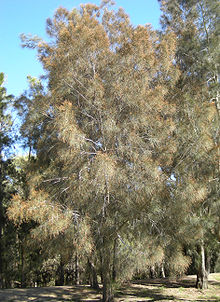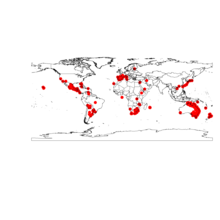Casuarina cunninghamiana
| Casuarina cunninghamiana | |
|---|---|

| |
| Casuarina cunninghamiana tree in flower. | |
| Scientific classification | |
| Kingdom: | Plantae |
| Clade: | Tracheophytes |
| Clade: | Angiosperms |
| Clade: | Eudicots |
| Clade: | Rosids |
| Order: | Fagales |
| Family: | Casuarinaceae |
| Genus: | Casuarina |
| Species: | C. cunninghamiana
|
| Binomial name | |
| Casuarina cunninghamiana | |

| |
| Occurrence data from GBIF[ | |
Casuarina cunninghamiana, commonly known as river oak or river she-oak,[3] is a she-oak species of the genus Casuarina. The native range in Australia extends from Daly River in the Northern Territory, north and east in Queensland and eastern New South Wales.[4][5]
Description[]


The River Oak is an evergreen tree with fine greyish green needle-like foliage that grows to a height of 10–35 m (33–115 ft) with a spread of about 10 metres (33 ft).[4][6] The trunk is usually erect, with dense rough bark. Flowers are reddish-brown in the male and red in the female.[4] Cones are small, nearly round to elongated and about 10 millimetres (0.39 in) across.[4]
Habitat[]
Trees are usually found in sunny locations along stream banks and swampy areas.[4] It's widely recognised as an important tree for stabilising riverbanks and for soil erosion prevention accepting wet and dry soils. The foliage is quite palatable to stock.[5] C. cunninghamiana is frost tolerant down to around −8 °C (18 °F) and is widely used effectively as a screening plant. It is useful on windy sites and is also suited to coastal areas. C. cunninghamiana has been introduced into several other countries for the purpose of agroforestry.[6]
Subspecies[]
There are two subspecies:
- C. cunninghamiana subsp. cunninghamiana. Large tree to 35 m (115 ft) tall. Eastern New South Wales, north and east Queensland.[4][6]
- C. cunninghamiana subsp. miodon. Small tree to 12 m (39 ft) tall. Daly River and Arnhem Land in the Northern Territory and the Gulf of Carpentaria in Queensland.[4][6]
The species has many common names including River Oak, River She-oak or Creek Oak.[5]
Invasive species[]
Casuarina cunninghamiana is an invasive species in the Everglades in Florida[7] and in South Africa.[8]
References[]
- ^ "Casuarina cunninghamiana". Australian Plant Name Index, IBIS database. Centre for Plant Biodiversity Research, Australian Government.
- ^ Miquel, F.A.W. (1848) Revisio critica Casuarinarum: 56, t. VI A
- ^ Casuarina cunninghamiana Miq.
- ^ a b c d e f g Boxshall, Ben; Jenkyn, Tim. "River she-oak" (PDF). Department of Primary Industries. Victorian Government. Archived from the original (PDF) on 15 September 2009. Retrieved 23 April 2011.
- ^ a b c Boland, D. J.; Brooker, M. I. H.; Chippendale, G. M.; McDonald, M. W. (2006). Forest trees of Australia (5th ed.). Collingwood, Vic.: CSIRO Publishing. p. 80. ISBN 0-643-06969-0.
- ^ a b c d "Casuarina cunninghamiana". Florabank. Retrieved 23 April 2011.
- ^ "Biological control of Australian native Casuarina species in the USA". Commonwealth Scientific and Industrial Research Organisation. 16 May 2007. Archived from the original on 5 June 2011. Retrieved 16 September 2010.
- ^ "SANBI:Declared Weeds & Invader Plants". South African National Biodiversity Institute. Archived from the original on 6 October 2014. Retrieved 25 September 2014.
External links[]
- Australian Biological Resources Study
- GBIF: Casuarina cunninghamiana (showing occurrence data and further images)
- Casuarina
- Trees of Australia
- Fagales of Australia
- Flora of Queensland
- Flora of New South Wales
- Drought-tolerant trees